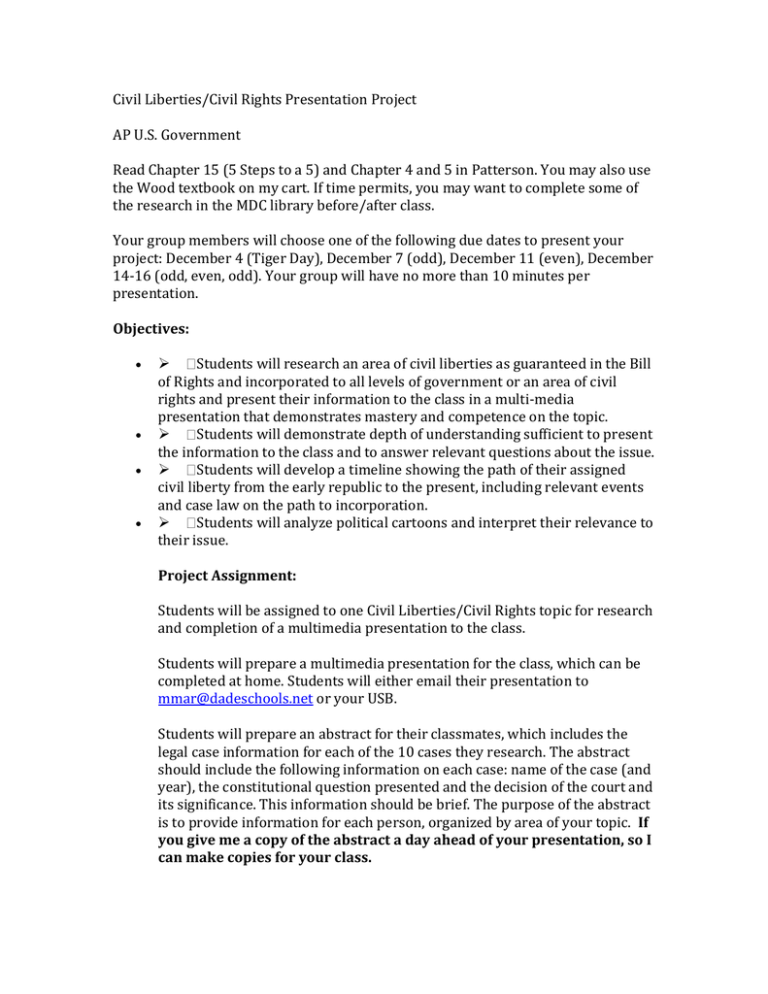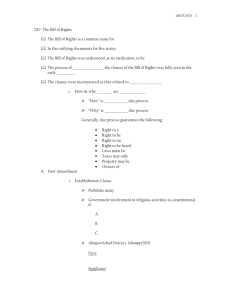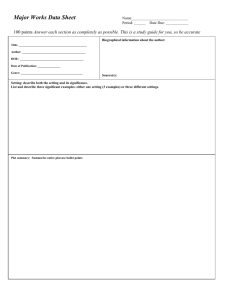Civil Liberties/Civil Rights Presentation Project AP U.S. Government
advertisement

Civil Liberties/Civil Rights Presentation Project AP U.S. Government Read Chapter 15 (5 Steps to a 5) and Chapter 4 and 5 in Patterson. You may also use the Wood textbook on my cart. If time permits, you may want to complete some of the research in the MDC library before/after class. Your group members will choose one of the following due dates to present your project: December 4 (Tiger Day), December 7 (odd), December 11 (even), December 14-16 (odd, even, odd). Your group will have no more than 10 minutes per presentation. Objectives: Students will research an area of civil liberties as guaranteed in the Bill of Rights and incorporated to all levels of government or an area of civil rights and present their information to the class in a multi-media presentation that demonstrates mastery and competence on the topic. Students will demonstrate depth of understanding sufficient to present the information to the class and to answer relevant questions about the issue. Students will develop a timeline showing the path of their assigned civil liberty from the early republic to the present, including relevant events and case law on the path to incorporation. Students will analyze political cartoons and interpret their relevance to their issue. Project Assignment: Students will be assigned to one Civil Liberties/Civil Rights topic for research and completion of a multimedia presentation to the class. Students will prepare a multimedia presentation for the class, which can be completed at home. Students will either email their presentation to mmar@dadeschools.net or your USB. Students will prepare an abstract for their classmates, which includes the legal case information for each of the 10 cases they research. The abstract should include the following information on each case: name of the case (and year), the constitutional question presented and the decision of the court and its significance. This information should be brief. The purpose of the abstract is to provide information for each person, organized by area of your topic. If you give me a copy of the abstract a day ahead of your presentation, so I can make copies for your class. Each presentation will include: The text of the amendment in question, including an explanation of the meaning of the amendment originally and current interpretation, and relevant Supreme Court cases illustrating the path to incorporation on this issue. I have provided a few relevant cases to your group’s research. You may also refer to your textbooks as well. Students are responsible for finding additional case law on the issue to include in their presentations. A minimum of two political cartoons illustrating divergent opinions on the issue. Explanation of the evolution of constitutional interpretation of the civil liberties/civil rights. Substantive discussion of the impact of constitutional interpretation, including application of the interpretation in public policy At least one multimedi2a item (video clip, podcast, music selection) relating to the topic of the civil liberty/civil right. I. Freedom of Religion Students will present an explanation of both the Establishment Clause and the Free Exercise Clause, including the following cases: Cantwell v. Connecticut Everson v. Board of Education Engel v. Vitale Lemon v. Kurtzman Employment Division of Oregon v. Smith Students should find at least 5 more cases, including at least one case within the past decade. Refer to pages 174-175 in 5 Steps to a 5 for more court cases. Your presentation should include the relevant information about each case, including the decision of the court and the significance of the decision. You should also include the impact of this decision on public policy. II. Freedom of Expression Students will include an explanation of freedom of expression, including pure speech and symbolic speech, including the following cases: Schenck v. United States Gitlow v. New York Miller v. California Tinker v. Des Moines Texas v. Johnson Students should find at least 5 more cases, including at least one case within the past decade. Refer to pages 175-177 in 5 Steps to a 5. Your presentation should include the relevant information about each case, including the decision of the court and the significance of the decision. You should also include the impact of this decision on public policy.III. Freedom of the Press Students will include an explanation of freedom of the press, including written and broadcast media press, including the following cases: o o o o o Near v. Minnesota New York Times v. United States Roth v. United States Branzburg v. Hayes Red Lion Broadcasting Company v. Federal Communications Commission Students should find at least 5 additional cases, including at least one case within the past decade. Your presentation should include the relevant information about each case, including the decision of the court and the significance of the decision. You should also include the impact of this decision on public policy. IV. Searches and Seizure Fourth Amendment: Basic search & seizure protections including the following cases: Wolf v. Colorado Mapp v. Ohio Terry v.Ohio Dow Chemical Co. v. U.S. Nix v. Williams United States v. Leon Students should find at least 5 more cases, including at least one case within the past decade. Your presentation should include the relevant information about each case, including the decision of the court and the significance of the decision. You should also include the impact of this decision on public policy. V. Property Rights: Right to Privacy This group will also present the importance of the Fifth Amendment, Sixth Amendment and Eighth Amendment (See pages 178-179 in 5 Steps to a 5). Griswold v. Connecticut Roe v. Wade Students should find at least 5 more cases, including at least one case within the past decade. Your presentation should include the relevant information about each case, including the decision of the court and the significance of the decision. You should also include the impact of this decision on public policy. th th VI. Due Process Students will include an explanation of due process rights, including substantive and procedural due process and eminent domain, including the following cases: o Miranda v. Arizona o Richards v. Jefferson County o Smith v. Phillips o Wolff v. McDonnell o Barron v. Baltimore o Berman v. Parker o Students should find at least 4 more cases, including at least one case within the past decade. Your presentation should include the relevant information about each case, including the decision of the court and the significance of the decision. You should also include the impact of this decision on public policy. VII. Criminal Trial Rights Students will include an explanation of criminal trial rights, including right to counsel, right to impartial jury and right to compulsory process for obtaining witnesses, including the following cases: o Powell v. Alabama o Miranda v. Arizona o Pointer v. Texas o Parker v. Gladden o Washington v. Texas o Students should find at least 5 more cases, including at least one case within the past decade. Your presentation should include the relevant information about each case, including the decision of the court and the significance of the decision. You should also include the impact of this decision on public policy. VIII. Minorities and Equal Rights Students will include an explanation of the issue of civil liberties/rights relating to minorities in our culture and workplace including the issues of “separate but equal” treatment, civil rights acts legislation and the issues surrounding this, including the following cases: Plessy v. Ferguson Shelley v. Kraemer Brown v. Board of Education Swann v. Charlotte-Mecklenburg Board of Education Loving v. Virginia Students should find at least 5 more cases, including at least one case within the past decade. Your presentation should include the relevant information about each case, including the decision of the court and the significance of the decision. You should also include the impact of this decision on public policy. IX. Women and Equal Rights Students will include an explanation of the issue of civil liberties relating to women in our culture and workplace. Including the issues of sexual harassment, employment discrimination and right to privacy, including the following cases: Reed v. Reed Craig v. Boren Griswold v. Connecticut Roe v. Wade Gonzales v. Carhart Students should find at least 5 more cases, including at least one case within the last decade. Your presentation should include the relevant information about each case, including the decision of the court and the significance of the decision. You should also include the impact of this decision on public policy. X. Equality of Results/Equality of Opportunity Students will include an explanation of the issue of civil rights with regard to the affirmative action arguments (pro and con) relating to minorities, women, and the handicapped, including the following cases: Regents of the University of California v. Bakke United Steelworkers v. Weber Richmond v. Croson Grutter v. Bollinger Gratz v. Bollinger Students should find at least 5 more cases, including at least one case within the last decade. Your presentation should include the relevant information about each case, including the decision of the court and the significance of the decision. You should also include the impact of this decision on public policy.





